![]()
![]()
![]()
Use LEFT and RIGHT arrow keys to navigate between flashcards;
Use UP and DOWN arrow keys to flip the card;
H to show hint;
A reads text to speech;
62 Cards in this Set
- Front
- Back
|
Parasitism |
A type of durable intimate interspecific interaction where one species (the host) is harmed at least in some way by the other (the parasite) |
|
|
Phorsey |
When a guest hitches a temporary ride; "travelling together"
|
|
|
Inquilinism |
When a guest makes a home inside a host but doesn't harm the host |
|
|
Definitive Host |
Parasite reaches sexualy maturity |
|
|
Intermediate Host |
Parasite development; not reach sexual maturity |
|
|
Paratenic/Transport Host |
No parasite development, but remains alive and infective |
|
|
Reservoir Host |
Animal with infection that can be transmitted to humans |
|
|
The Four Great Parasitic Groups |
1. Platyhelminthes - Monogeneans, trematodes, cestodes 2. Nematodes- Roundworms, pinworms, filarial worms 3. Arthropods- Crustacea, ticks, mites, insects 4. Protists- Amoebae, flagellates, apicomplexans |
|
|
Phylum Platyhelminthes |
-Triploblastic -Bilateral Symmetry -Flattened dorsoventrally "flat worms" -No internal body space -Digestive system incomplete -Excretory system with protonephridida (flame cells) -Most are hermaphrodites; internal fertilization |
|
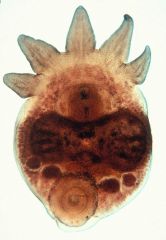
|
Class Turbellaria Order Temnocephalida -most are free-living predators -ectocommensals on crustaceans -tentacles on anterior end; weak sucker on posterior end |
|
|
Class Turbellaria Order Dalyelloida |
-Little to no pathology -Many are in the gut/body cavity of echinoderm
|
|
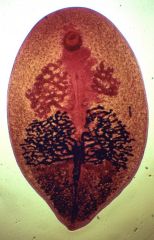
|
Class Turbellaria Order Dalyelloida Synedsmis -in Sea Urchins |
|
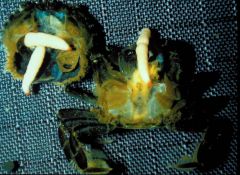
|
Class Turbellaria Order Dalyelloida Fecampia |
|
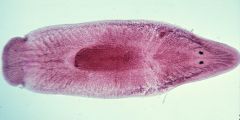
|
Class Turbellaria Order Tricladida Bdelloura candida |
|
|
Phylum Platyhelminthes Class Monogenea |
-primarily on fishes (external) -can be a serious threat when fish are crowded; hatcheries -Host specific= narrow niche -has an opisthaptor (w/ partial symmetry) -bilateral symmetry
|
|
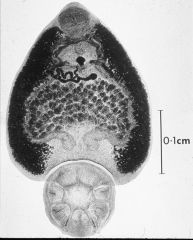
|
Monogean (notice opisthaptor) |
|

|
Gyrodactylus -from a Stickleback |
|
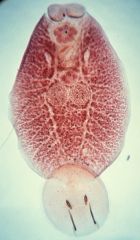
|
Benedenia melleri Monogean |
|
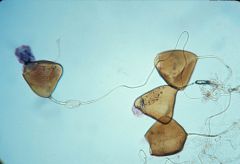
|
Monogenean eggs (purple) and oncomiracidium |
|
|
Term for the larval stage of a Monogenean? |
Oncomiracidium
|
|
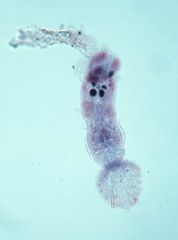
|
Oncomiracidium - 1 to 2 eye spots -posterior end = attachment organ with hooks (retained in adults) -larvae swim until contacting a host, lose ciliated cells, then develop into adults |
|

|
Undonella -a hyperparasitic (parasite on a parasite) monogenean on parasitic copepods -only found on hippo eyes |
|
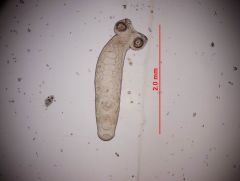
|
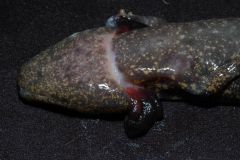
Sphyranura - only found on mudpuppy gills
|
|
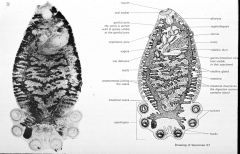
|
Polystoma integerrium -three sets of suckers on opisthaptor -found on the mouth, esophagus, and urinary bladder of frogs -adapted to the life cycle of the frog |
|
|
Class Trematoda Subclass Aspidobothrea |
-huge ventral sucker (opisthaptor) extending most of the length of the body -parasite of snails and clams -most have one host; in digestive tract -all are parasitic
|
|
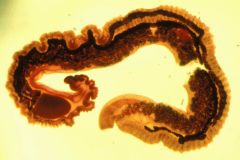
|
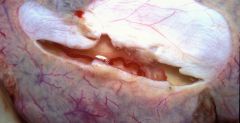
Subclass Aspidobothrea Multicalyx |
|
|
Larval stage of an Aspidobothrean? |
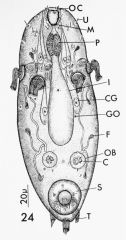
Cotylocidium |
|

|
Aspidogaster conchicola -from Chinese Mystery Snail -eggs hatch in molluscan host and young develop without further mitigation |
|
|
Class Trematoda Subclass Digenea |
-make up 95% of trematodes -ventral sucker (asitabulum) and oral sucker -development occurs in 2 or more hosts -1st = mollusc - 2nd= vertebrate
|
|
|
Digenean Life Cycle |
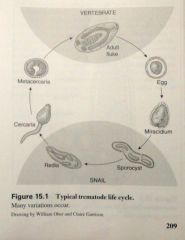
Miracidium (cilliated, free-swimming larva) enters 1st intermediate host (snail) -> sporocyst (embyos) develop asexually to become -> rediae develop further to become cercariae -> emerge from snail -> develop into metacercariae (infective to definitive host or infect another intermediate host) |
|
|
Class Trematoda Subclass Digenea Schistosoma |
-most prevalent in Africa, also in South Africa -live as adults in blood vessels (in the mesenteric veins) -aka blood flukes -release about 1000 eggs/day -disease is called schistosomiasis -pathological sign= blood in urine -have separate sexes -each species is specific to a species of snail |
|
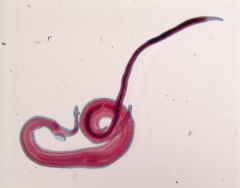
|
Schistosoma mansoni -grooves in the male body (gynecophoric canal) holds female |
|
|
Prevalence |
The proportion of hosts infected by a species of parasite |
|
|
Intensity |
the number of parasites of a species in an individual host |
|
|
Mean Intensity |
The mean number of individuals of a parasite species amoung infected hosts |
|
|
Schistosome Life Cycle |
-eggs are distributed into freshwater and when in water eggs hatch and develop into miracidium with cilia -when finding a snail (intermediate host), miracidium penetrates the skin and make its way inside the body and develops into a mother sporocyst which then asexually reproduces more sporocysts -daugther sporocysts migrate to snail's reproductive tissue and destroys it and stays there -develops into cercariae that are excreted by the snail -cercariae must then find a human host (definitive host) |
|

|
Schistosoma mansoni egg with miracidium (inside) |
|
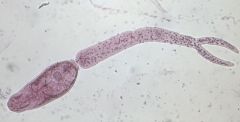
|
Schistosoma cerecaria |
|
|
Schistosome Control |
-chemotherapy (expensive) -vaccines -molluscicides (kill the molluscs) -enviro manipulations -education -biocontrol (less effective) **Best way= interrupt parasite life cycle |
|
|
Concomitant Immunity |
If you have a few worms already, you can't be infected again while you have the worms |
|
|
Generalized Digenean Life Cycle |
Egg -> miracidium -> sporocyst -> redia -> cercaria -> metaceracaria -> adult |
|
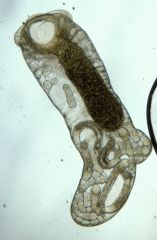
|
Redia (note pharynx and gut) |
|

|
Metacercariae |
|
|
Trophic Transmission |
Parasite is transmitted to next host by a predation event |
|
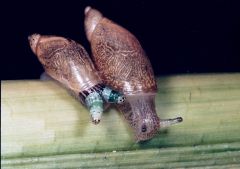
|
Leucochloridium in snail -snail's tentacles become brightly colored and striped to attract predators (birds) -no secondary host needed -parasite reproduces in bird and bird defecates the eggs everywhere |
|
|
Clinostomum marginatum Life Cycle |
-Eggs defecated by birds -miracidium penetrates snail -asexually reproduces in snail to cercariae -cercarae released from snail and develop into metacercariae -metacercaria infect fish -birds eat the fish and cycle starts over |
|
|
Phylum Platyhelminthes Class Cestoda |
Tapeworms! -absorb nutrients through surfaces -each proglottid (segment) can reproduce -Scolex -attaching mouth part -looks differant depending on development stage -neck is the region of rapid growth of more proglottids |
|
|
Proglottid |
-Reproductive segments of tapeworms -immature proglottids lack reproductive organs -gravid (filled with eggs) proglottids release eggs and are near the end of the worm -dropped off when eggs released |
|
|
Tegument |
-cestode surface -microthrix = finger-like projections cover the surface in order to maximize surface area |
|
|
Cestode Nurtient Absorption |
-better than the host! -carbohydrates are the limiting factor -worms can only absorb monosaccarides -host digestive rate will increase
|
|
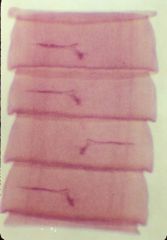
|
Immature proglottid |
|
|
/ |
Hymenoleptis -primarily a rat tapeworm -have 3 testes and 1 ovary in each gravid proglottid -only takes a little bit of nutrients, not hard on host -uninfected/infected rats have very similar intestinal absorpition rates |
|
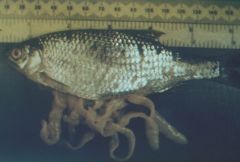
|
Ligula -plerocercoids -prefers the carp family -grows very quickly in secondary host (fish) |
|
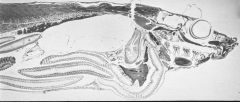
|
Schistocephalus -plerocercoids in Stickleback fish -causes a lot of damage -fish cannot keep up with nutrient demand so it stays in shallow water where it is easier to find food, but predation risk is higher -birds (definitve host) eat the fish |
|
|
PITT |
Parasitic Increased Trophic Transimission -metacercariae modify behavior of intermediate host so they are more likely to be consumed by the definitive host |
|
|
Phylum Platyhelmintes Class Cestoda |
-body = monozoic (tapeworm whose strobila consits on one segment) or polyzoic -Strobilation -eggs with infective oncosphere; oncospher has hooks for crossing intestinal wall -infected intermediate hosts eaten by definitive host -diverse taxonomic group (scolices; reproductive arrangements, life cycle variation) |
|
|
Class Cestoda Subclass Eucestoda Order Diphyllobothriidea (= Psuedophyllidea) |
-scolex has a bothria |
|
|
Hymenalypis dimenuta |
-found in rats and people -only 1 intermediate host (beetle), but its not required -oncosphere -> cysticercoid -scolex develops first (invaginated), and projects when consumed by definitive host
|
|
|
Hymenalypis nana |
-dwarf tapeworm (nana) -similar to H. dimenuta -children are commonly infected |
|
|
H. dimenuta Life Cycle |
-eggs defectated by humans -ingested by an arthropod (intermediate host) -oncosphere hatches and penetrates intestinal wall -cysticerci in insect ingested by rodent or human (infective stage) -develops into an adult in definitve host |
|
|
Class Cestoda Subclass Eucestoda Order Cyclophyllidea |
-very large subclass -important to the medical field -Scolex has 4 suckers with a rounded tip (rostellum)
|
|
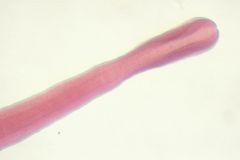
|
Diphyllobothrium latum -scolex has bothria - |

